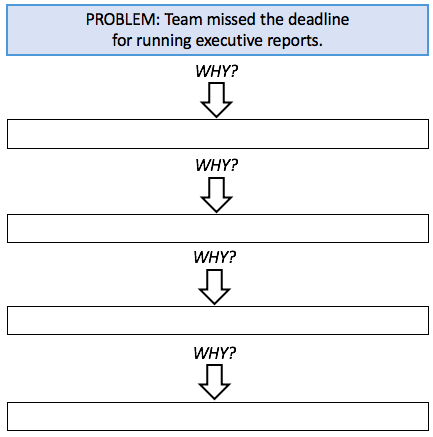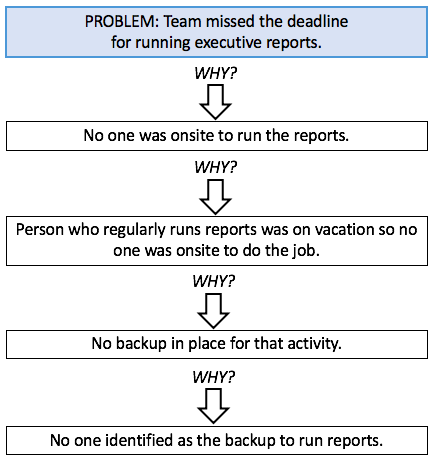The 5 Whys root cause analysis tool helps you quickly get past surface assumptions. It helps you dig deeper so you can solve the root cause of the problem.
What is the 5 Whys Root Cause Tool?
The 5 Whys is a simple tool used to help you understand what’s really causing a problem.
If you’ve got a problem that needs addressing, it can be beneficial to look deeper to understand what the root cause of the problem may be.
The 5 Whys helps you do that.
It’s called the 5 Whys because it usually takes five iterations of asking “Why” to get to the root cause of a problem in order to best address it.
It’s called the 5 Whys because it usually takes five iterations of asking “Why” to get to the root cause of a problem in order to best address it.
When and Why to Use the 5 Whys Root Cause Tool
Use the 5 Whys when you want a simple way to dig for deeper understanding of the root cause of a problem.
You might first take your problem at face value but digging deeper can give you more insight into the root cause. This allows you to solve the problem without making assumptions or only focusing on surface-level items.
Going through the exercise helps you dig deeper into your problem to determine the root cause, so you can better address it.
Benefits to the 5 Whys as a Problem-Solving Tool
- It’s easy.
- It doesn’t require high-tech or complicated tools.
- It can be done relatively quickly.
- It can foster teamwork and common understanding of a problem.
And because you do this with a team, you get better insight and information, multiple perspectives, and are likely to get a better outcome than making assumptions about what’s causing the problem.
Here’s How to Do It in 5 Easy Steps
Before you start the 5 Whys activity, make sure you do this with a team of people who have insight into the problem.
1. Explain the process to the team.
Let them know how this exercise works in case anyone isn’t familiar with it. Make sure they know this isn’t about finding blame. Instead, it’s about problem-solving.
2. Clearly identify the problem.
Make sure that everyone has the same understanding and is in agreement with the problem you’re attempting to solve. Write the problem down so all can see it.
3. Ask Why.
Why did this problem occur?
4. Ask “Why?” four more times.
This is a rule-of-thumb. If you get to a root-cause that everyone agrees on at four questions, you can stop. If it takes a couple more times to find a real root-cause, it’s okay to add one or two more levels.
5. Identify a solution.
Now that you’ve identified the root cause, you can find a solution that addresses the root cause. Determine how you’ll address the problem.
5 Whys Example
To give you a better idea of what it looks like, let’s go through an example.
I’ll use an example from my book Bad Meetings Happen to Good People: How to Run Meetings That Are Effective, Focused, and Produce Results.
In this simple example, the problem is that the monthly Executive reports were not created and delivered.
1. Explain the process to the team. Explain the situation and the exercise you’ll go through. Make sure they know that the goal is to solve the problem by getting to the root cause, and not finding someone to blame it on.
Here’s the example situation you’re addressing: The VP informed your team she didn’t get the executive reports last month. There was a gap in reporting and she couldn’t answer questions in the monthly VP meeting. She had to request the information and the delays were problematic. It also caused the team to scramble to pull it together quickly.
2. Identify the problem statement: Team missed the deadline for running and delivering executive reports.

3. Ask “Why?” In our example, the first response might be that no one was on site who knew how to run the reports, or that they were due.

4. Ask Why several more times. This table illustrates several more layers of root-cause until you get to a root-cause level you feel is adequate.

5. Identify a solution. Now that you’ve identified the root cause, you can find a solution that addresses the root cause.
In our example, the solution to the problem would be to train other team members on how and when to run the reports.
Another Example to Illustrate
Reports show that day-shift employees have been doing poor quality work late in the workday, skipping important tasks, and creating extra work for the next shift. Conducting a 5 Whys Root Cause Analysis with day-shift workers results in the following responses:
Problem Statement: Day-shift staff have been skipping tasks and performing lower quality work in the last hour of the shift.
Why? We’re rushing to finish our work.
Why? We want to leave as early as possible.
Why? We want to leave before it gets dark outside, and it gets dark earlier now that Daylight Savings Time has ended.
Why? We don’t feel safe walking to the parking garage after hours in the dark..
Why? The parking garage is dark and feels unsafe.
Why? There is poor lighting and no security.
Now we can see there are safety issues in the parking garage that need to be addressed. This gives us insight to the root of the problem we may not have considered.
“No matter how good the team or how efficient the methodology, if we’re not solving the right problem, the project fails.”
–- Woody Williams
Summary
The 5 Whys is a great tool to use when you want to quickly get to the root cause and solve the right problem.
It promotes team problem-solving and buy-in for solutions.
And it usually doesn’t cost anything to do the exercise.
Give it a try in the spirit of continuous improvement and building trust.
And if you think others would benefit from this post, please share!
Read these posts for more great problem-solving tools:
The Osborn Parnes Creative Problem-Solving Process
7 Problem-Solving Steps to Conquer Even the Toughest Problems
How to Use the Ishikawa Fishbone Diagram as an Awesome Problem-Solving Tool
How to Run a Successful Brainstorming Session for Productive Problem-Solving
Thank you! I came across your website in a search for how to write an opportunity statement, which lead me to this post. I think it is important to point out that this method is also very valuable in uncovering the “why” in personal blocks, as in my case, of moving forward with my thesis and formulation of my opportunity statement. In feeling such resistance and a block to moving forward in my project I applied the 5 Why’s method to asking myself why I was struggling to complete this task. After a deep dive of about 4 rounds I discovered the root cause and released the limiting belief that was holding me back. After, in 5 minutes, I was able to pull together my statement and it flowed effortlessly.
It’s always good to reflect on the need to do our own personal work to succeed in our professional work.
good job Ms. Espy
Thank you! I appreciate it!
Leigh